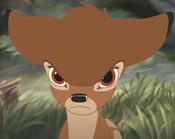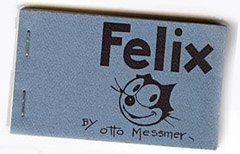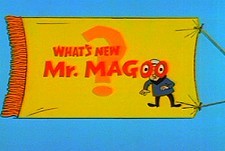 Walt Disney 1935. From the U.K. Daily Express Filmbook of 1935: “There are only 201 men and women in the world who know how hard it is to make a Silly Symphony. These are Walt Disney and his 200 assistants at the Disney Studios, Hollywood. Walt himself always speaks for Mickey Mouse. Once having done so he has to keep it up, as you would recognize a different voice at once if you heard it. Incidental sounds as in radio are produced in extraordinary ways. If you beat with your fingers on a felt hat you can produce the sound of a motor boat. If you rub your fingers in a little sand, held in the palm of the other hand, you can make the noise of a giant eating a piece of celery.
Walt Disney 1935. From the U.K. Daily Express Filmbook of 1935: “There are only 201 men and women in the world who know how hard it is to make a Silly Symphony. These are Walt Disney and his 200 assistants at the Disney Studios, Hollywood. Walt himself always speaks for Mickey Mouse. Once having done so he has to keep it up, as you would recognize a different voice at once if you heard it. Incidental sounds as in radio are produced in extraordinary ways. If you beat with your fingers on a felt hat you can produce the sound of a motor boat. If you rub your fingers in a little sand, held in the palm of the other hand, you can make the noise of a giant eating a piece of celery.
“As for Walt Disney himself, he is a quiet, amused deep-eyed little man of 33 who doesn’t care much what clothes he wears or what food he eats so long as he can get along with Mickey. He does not look very like an American but more like a Frenchman with a half-sad, half-amused face. But is there anyone else in the world who gives pleasure to such millions of people? Has any man since the world began caused more laughter and happiness?”
 Ban Bambi. When Disney’s animated feature film Bambi was released in 1942, Raymond J. Brown, then editor of Outdoor Life magazine, insisted that Walt add a foreword to the film acknowledging sportsmen’s contribution to wildlife. Walt refused and Brown labeled the film as “The worst insult ever offered to American sportsmen and conservationists”. Brown attempted to start a boycott of the film, but it proved to be ineffectual.
Ban Bambi. When Disney’s animated feature film Bambi was released in 1942, Raymond J. Brown, then editor of Outdoor Life magazine, insisted that Walt add a foreword to the film acknowledging sportsmen’s contribution to wildlife. Walt refused and Brown labeled the film as “The worst insult ever offered to American sportsmen and conservationists”. Brown attempted to start a boycott of the film, but it proved to be ineffectual.
In the March 1980 Field and Stream magazine, there was an article by George Reiger that attacked both the book and Disney’s film for giving hunters a bad reputation. Writer Linda Gross in the Los Angeles Times June 18,1982 attacked the film as being sexist because it gave all the female characters “short shrift” and that “the girl animals don’t even get to frolic or play with the boy animals, unless you consider the mushy courtship stuff to be fun…There is always a strong father figure in the distance to take over or give advice in a pinch.”
Visionary Halas. In Variety January 13, 1982, it was stated that animator and producer John Halas was moving into “semi-retirement” but was still head of Halas & Batchelor, the oldest animation studio in the U.K. that the previous year had celebrated its 40th anniversary. According to the article, “Halas recently caused some local controversy with the printed assertion that conventional cel animation is on the way out. He believes that computer-generated work will account for the 90% of animation now dominated by the cel method by the end of the century.
“Most studios dispute this figure and agree with the journalists of the British scientific organ, New Scientist, who reporting on computer animation gabs at last September’s animation fest in Cambridge, came to the conclusion that computers would soon be a major part of the animation studio as slaves doing the backgrounds and copying but would not supplant the artist.”
 Scouse the Mouse. In early 1982, animation director Gerry Potterton announced he would be doing an animated TV series for ITV called Scouse the Mouse based on a book written by actor Donald Pleasence and illustrated by Potterton. A children’s album with Ringo Starr as Scouse (Scouse is a slang word for things from Liverpool) and Adam Faith as Bonce (a cockney mouse) was released in 1977 with Starr and Faith singing songs written by Pleasence and Roger Brown. Potterton who had directed Heavy Metal (1981) was also hoping to get another animated feature underway using the same animation studio. Due to a strike and other delays, the Scouse series was never made.
Scouse the Mouse. In early 1982, animation director Gerry Potterton announced he would be doing an animated TV series for ITV called Scouse the Mouse based on a book written by actor Donald Pleasence and illustrated by Potterton. A children’s album with Ringo Starr as Scouse (Scouse is a slang word for things from Liverpool) and Adam Faith as Bonce (a cockney mouse) was released in 1977 with Starr and Faith singing songs written by Pleasence and Roger Brown. Potterton who had directed Heavy Metal (1981) was also hoping to get another animated feature underway using the same animation studio. Due to a strike and other delays, the Scouse series was never made.
Wisdom of Bakshi. In New West magazine December 1978, animator and producer Ralph Bakshi said, “If the character doesn’t come up and grab you, forget it. Drawings are lifeless, but if you make the viewer forget pen and paper, make him feel something for the characters on the screen, then you’re an animator. If not, it’s just graphics.”
 Felix’s Appeal. From Cats magazine January 1, 1982 in an article by Roy Nuhn about Felix the Cat, he quotes a comment made by Otto Messmer “some years ago” about the appeal of the black feline: “He could be an alley cat one time, save the day for the losing Yankee baseball club the next and then be the pet of a rich princess. I tried to make Felix the way a little eight-year-old boy would think, wondering what’s up there under the stars, where the wind comes from, how it’s like in South Africa. He would go to Arabia, to Mars – not just to the barnyard. That’s what made him famous.
Felix’s Appeal. From Cats magazine January 1, 1982 in an article by Roy Nuhn about Felix the Cat, he quotes a comment made by Otto Messmer “some years ago” about the appeal of the black feline: “He could be an alley cat one time, save the day for the losing Yankee baseball club the next and then be the pet of a rich princess. I tried to make Felix the way a little eight-year-old boy would think, wondering what’s up there under the stars, where the wind comes from, how it’s like in South Africa. He would go to Arabia, to Mars – not just to the barnyard. That’s what made him famous.
“After seeing a Charlie Chaplin film, I went home and drew this angular black cat with big wide eyes to fill the white screen. I patterned him after Charlie Chaplin using his facial expressions and funny movements. The audience loved him. And so did Chaplin. The cartoon format let Felix do things that Chaplin couldn’t do on film.”
 Freleng’s Rocky and Bullwinkle. In 1980, supposedly De-Patie-Freleng was under the impression that it had the license to produce new episodes of the adventures of Jay Ward’s Rocky and Bullwinkle characters just as they had produced new episodes of U.P.A.’s Mr. Magoo for Saturday morning (What’s New, Mr. Magoo? 1977). However, when I interviewed producer, writer and voice talent Bill Scott in September 1982, he told me “Jay had said he might be interested in having Friz (Freleng) produce the cartoons if we could write the stuff and keep the creative control. But that’s as far as it went. It never got to rights. It never got into any commitment.” In addition, apparently they could not find a network that was interested in the series.
Freleng’s Rocky and Bullwinkle. In 1980, supposedly De-Patie-Freleng was under the impression that it had the license to produce new episodes of the adventures of Jay Ward’s Rocky and Bullwinkle characters just as they had produced new episodes of U.P.A.’s Mr. Magoo for Saturday morning (What’s New, Mr. Magoo? 1977). However, when I interviewed producer, writer and voice talent Bill Scott in September 1982, he told me “Jay had said he might be interested in having Friz (Freleng) produce the cartoons if we could write the stuff and keep the creative control. But that’s as far as it went. It never got to rights. It never got into any commitment.” In addition, apparently they could not find a network that was interested in the series.
Never Made. In early 1982, Kurtz & Friends, a Hollywood animation studio had contracted with Comworld Productions to provide animated programming. Among the projects that Kurtz & Friends were working on were an unnamed F. Scott Fitzgerald property, Allen Reubin’s The Almost Complete Book of Monster Etiquette and an hour long special entitled The Illustrated George Carlin that was to combine animated sequences with footage of a Carlin performance.
Carlin did provide the track for Kurtz’1985 short Drawing On My Mind.


 Jim Korkis is an internationally respected animation historian who in recent years has devoted his attention to the many worlds of Disney. He was a columnist for a variety of animation magazines. With his former writing partner, John Cawley, he authored several animation related books including The Encyclopedia of Cartoon Superstars, How to Create Animation, Cartoon Confidential and Get Animated’s Animation Art Buyer’s Guide. He taught animation classes at the Disney Institute in Florida as well as instructing classes on acting and animation history for Disney Feature Animation: Florida.
Jim Korkis is an internationally respected animation historian who in recent years has devoted his attention to the many worlds of Disney. He was a columnist for a variety of animation magazines. With his former writing partner, John Cawley, he authored several animation related books including The Encyclopedia of Cartoon Superstars, How to Create Animation, Cartoon Confidential and Get Animated’s Animation Art Buyer’s Guide. He taught animation classes at the Disney Institute in Florida as well as instructing classes on acting and animation history for Disney Feature Animation: Florida.




















































On Ban Bambi I’m surprised that the “Animal Rights”/Ecoterrorist group PETA (People for the Ethical Treatment of Animals) didn’t try to ban the film after the treatment of Bambi’s mom after she was slain (off screen) by the hunter.
At one point in the early history of Disney Television Animation, the company thought that they had the rights to Rocky & Bullwinkle as well. Gary Krisel, then head of television animation, put a few men on it to develop it into a new show, pulling back the reigns after a few weeks when he realized Disney only had the video rights and not the rights to produce new animation.
The name of the Heavy Metal director is Gerry Potterton, not Gerry Potterson.
As editor of this blog, I should have caught that. Thanks, Tom – it’s now been corrected.
Very interesting note on the possibility of a DFE-produced Rocky & Bullwinkle! I would have loved to see how that would have turned out!
I can’t see how anyone could do a better job on ROCKY AND HIS FRIENDS or THE BULLWINKLE SHOW than Jay Ward and Bill Scott! If the characters ever lost that adult edge, the whole thing would lose its appeal. Also, wouldn’t anyone see how the show represented the times in which it lived? This isn’t kid vid, folks! I’ve always liked the character of FELIX THE CAT, beginning with the TV series. Hey, it is the first version I saw before I was introduced to the Van Buren cartoons on the transitioning “EARLY BIRD CARTOON SHOW”. Now, Felix is a flexible character and, if surrealist animators are in charge, new and inventive series around Felix could be a lot of fun. What did all of you think of the latest version of the character?
Under DFE, the animation would have been done domestically, for one.
The timing might have killed the Bullwinkle revival. 1980 was when Freleng retired and the whole operation was being sold to Marvel Comics.
John Halas was quite right about that.
https://www.youtube.com/watch?v=SclGfTrgnIQ